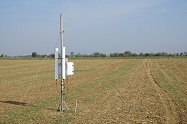Cosmic-Ray Neutron-Sensing: soil moisture determination with cosmic neutrons
Cosmic-Ray Neutron Sensing (CRNS) is a mobile, non-contact technology for determining mean soil moisture in the vicinity of about 15 hectares. The method is based on the detection of neutrons "reflected" from the soil. Since these are particularly sensitive to hydrogen atoms, a direct dependence of neutron intensity on the prevailing water in the root zone around the sensor can be deduced. Since the neutrons are derived from cosmic events, such as stellar explosions, this measurement method is called Cosmic-Ray Neutron Sensing.
 Cosmic-Ray station
Cosmic-Ray station
(photo: UFZ)
The UFZ has installed Cosmic-Ray stations at several locations. In the map below the measurement data of the individual stations can be accessed.
Functionality and application of CRNS sensors:
Inside the sensor there are usually detector gases (e.g. helium) which react to neutrons passing through and generate a current pulse. These pulses are counted and stored in the data logger together with information such as GPS coordinates, temperature, air pressure and humidity. Based on the collected information, the soil moisture can be estimated from the signal.
The stationary sensors are already being used successfully in research and agriculture to measure hourly changes in soil moisture over several years.
A solid estimate of soil moisture at the landscape scale is also relevant for hydrological modeling. This can be used to predict future weather developments, for example to more accurately estimate the risk from droughts, heat waves or floods.
